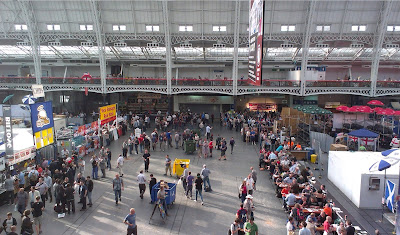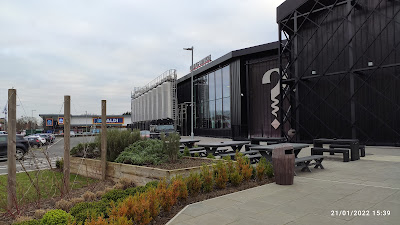"Tipping" is an a an act which, according to the Cambridge English Dictionary is, “giving an amount of money to someone who has provided a service, especially in a hotel or restaurant.” This is almost universally understood, especially in the British Isles, but further afield the act of tipping someone, takes on a much greater significance.
When further afield extends to across the Atlantic Ocean, and to the United States in particular, that “greater significance” is much more pronounced, but before making that crossing, I want to look first at what goes on in this country, and any conventions that might be attached to the practice.Like many people growing up in Britain, I learned that it was normal practice to offer an additional sum of money to people engaged in certain professions, particularly those who had rendered a service of one sort or another to you. That sum of money is usually referred to as a “tip,” although the correct technical, and probably legal term as well, is a “gratuity.” The tip, of course, is given in addition to the basic price of the service.
The occupations which normally warranted a tip were, hairdressers, taxi drivers and waiting staff – in restaurants. You were also expected to tip hotel porters, and possibly luggage porters at large railway stations, but as a child, the family never stayed at a hotel, and because we had a car, long-distance rail journeys were also, never undertaken. This leads onto the question of, how much should one tip? The answer was, and still is in many cases, 10% of the bill total or, in the case of exceptional service, a higher amount 15% upwards, and this has been a rule I have normally worked to, but none of it answers the question as to why some workers are deemed worthy of a tip, whilst most are not? I often thought, particularly when I was younger, that because no-one ever offered me anything extra for doing my job, why should I be expected to offer an additional payment to a stranger, just for doing theirs? I’m obviously older, and I’d like to think wiser as well, but offering gratuities does seem restricted to those who offer us a very personal service. Things don’t get much more personal than having our hair cut, and the fact that taxi drivers offer a personalised door to door service that often involves helping with a person’s luggage as well, brings them into the same category as well.Then there are the waiters and waitresses, the people who take our order in a restaurant, but also in something slightly more basic, such as a pub or bar. They don’t just scurry off with our order and then bring the food to our table. Sometimes they offer suggestions, or recommendations and, depending on the standing or status of the establishment, may even serve the food up in front of us. This also is a very personalised form of service and is why it is almost universal practice to give these people a tip.
But when and where to draw the line, and should you feel compelled to offer a tip, especially if you have received slow or poor service? This is where things become tricky, and boundaries can become blurred, but before going any further, it’s worth taking note of a small piece of advice, I once read. It said that the word “TIPS” is an acronym meaning To Insure Prompt Service, which almost implies handing over the gratuity, prior to receiving the goods or service – almost as if it were some form of insurance policy.Well, I don’t know about that, but it does rather tie in with what one researcher categorised as 5 motivations for tipping:
1. Showing off.
2. To supplement the server’s income and make them happy.
3. To improve future service – as mentioned previously.
4. To avoid disappointment from the server.
5. A sense of duty.
In my opinion, the first and the last of those “motivations” are probably the main ones for people to leave a tip, but before looking at the history behind the origins of this practice, let’s make that journey across the Atlantic to the good old US of A. I discovered there, more or less straight away, that waiting staff in establishments ranging from top nosh restaurants to the humble diners, not only expect a gratuity for their services, but are also quite adept at showing their feelings when they don’t receive one. The same applies in bars, even where the staff are just pouring you a drink. I found this out in a bar at Cincinnati Airport, whilst waiting for a connecting flight. I had only just arrived in the country, and after an unfortunate incident involving a Customs & Border Protection agent, I really needed a beer. I describe the “incident” as unfortunate and whilst with hindsight, the remark I made wasn’t perhaps the most sensible thing I’ve uttered, but if whilst queuing to enter a foreign country, you are asked the question below, you might be tempted to give a similar response.“Do you have more than $100,000 about your person?” To which I
replied, “No, but I wish I had!” Ask a daft question and expect an equally daft answer, was my logic, but like most government officials CBP agents are lacking in a sense of humour, and I was told, rather firmly, to stand to one side, asked all sorts of other questions, whilst a detailed search of my luggage was conducted. It could have been worse, and there were no invasive body searches, or anything similar involved, so after feeling rather foolish, I was looking forward to that beer!It was America, and people sit at the bar. This type of behaviour is frowned
upon back home, and viewed as “bar blocking,” at least amongst most of the people I mix with, but seems the norm in the US. There was a good selection of beers available, although I can’t remember now which one, I opted for. They were dispensed of course, from an array of different taps, mounted along the back wall, directly opposite where I was sitting. All the bar person had to do was pick up a glass, pour the beer, turn around and plonk it on the counter in front of me, so I thought little of it. I handed over a $10 bill, pocketed the change and started necking my first beer on American soil. I thought the bar tender had looked rather strangely at me, when I pocketed the change, and it wasn’t until the woman sitting next to me, pointed out that I should have given a tip, that the penny dropped. A tip for pouring a beer – a task that involved a minimum of effort, and yet they expected a gratuity? I pleaded ignorance and muttered something about tipping double for the next beer, except there wasn’t a next beer, because when the same woman asked me which part of Australia I was from, I decided the conversation was going nowhere, and it was time to leave. The experience did prove an important lesson in awareness of the different customs and behavioural etiquette that might be encountered in a foreign country, and over the course of that visit and the subsequent one, I slowly became acclimatised to the requirement for tipping. My sister and her American husband were at pains to explain that hospitality staff, in the US, relied on gratuities to supplement the low, basic wage they received. I can understand this if it wasn’t expected. As argued earlier, a tip or gratuity is offered for the personalised service received, as per a haircut, or help with one’s luggage. Flicking the lever of a tap with your index finger, does not exactly tick the box of “personal service” in my book! Despite having now lived a quarter of a century in the USA, my sister has similar views to my own, namely pay your workers a decent living wage so they don’t need to rely on the vagaries of gratuities but returning briefly to the question of “entitlement” it’s worth sharing the following story, relating to my last visit.The three of us had been out for the day – if my memory serves me correctly it was a drive along to the area of downtown Cleveland, known as The Flats. This is a thriving area of bars, restaurants and boutiques that has sprung up quite recently along the banks of the Cuyahooga River before
it flows into Lake Eire. After an afternoon wandering around several street markets, and calling in at the odd bar or two, we were feeling rather peckish, so decided to pick up a Chinese takeaway on the way back to the house.I said I would pick up the tab, so my brother-in-law phoned the order through, and 30 minutes or so we turned up at the restaurant to collect the meal. All very straight forward until I went to pay, and my brother-in-law informed me I needed to add a tip. “For a takeaway?” I said, “are you kidding?” “No, it's expected,” was my brother-in-law's reply. So reluctantly, and bearing in mind I was in a foreign country, I added the 15% to the “add service gratuity” option on the card machine.
My sister, who had been waiting in the car, felt embarrassed, and agreed with me that a gratuity for a takeaway, that you pick up yourself, was taking the p*ss. As with pouring the beer, handing over a carrier bag full of foil containers, wasn’t in my view worthy of extra payment, even though the meal itself was excellent. Perhaps the money should have gone to the chef, rather than the bloke behind the counter?Returning closer to home, and to trips to Europe – remember them? As we know, table service is pretty much universal across most of the continent, even if you are just stopping by for a few beers. Even closer than western Europe, is Britain itself where, for several parts of the pandemic, pubs and bars were required, by the Covid- restrictions, to operate on a table-service only basis.
It wasn’t popular with customers or with publicans, meaning extra waiting times for customers, and increased staffing costs and slower turn-over for landlords. We’re just not used to this type of service in the UK, and if I’m honest, I often find it rather frustrating when I’m abroad., as well.
I’ve raised the subject of table service primary because it relates to tipping again, and the verdict is that in much of Europe, tipping, whilst welcomed, is not automatically expected. I will normally round a bill up to the nearest whole number, or perhaps add a couple of extra Euros if the food, drink, and the evening were exceptionally good.The same, of course, applies here in the UK, where again there is no automatic expectation of a tip. This does rather leave the United States out on a limb, and whilst the intention of this article, right from the start, was
not to knock our friends and, in my case, relations on the other side of the Atlantic, one does have to ask why one of the richest and most powerful nations on earth leaves millions of its workers reliant on the generosity of others, rather than paying them a true living wage.Final word on the subject – tipping very much depends on the customs and social etiquette of the country you are visiting. As already covered, tipping is expected in the USA, but there are also parts of the world where it is discouraged and may even be considered as insulting. Japan and Korea fall into this category, so the best advice is to follow local practice, and remember the old adage of “When in Rome, do as the Romans.”

















































